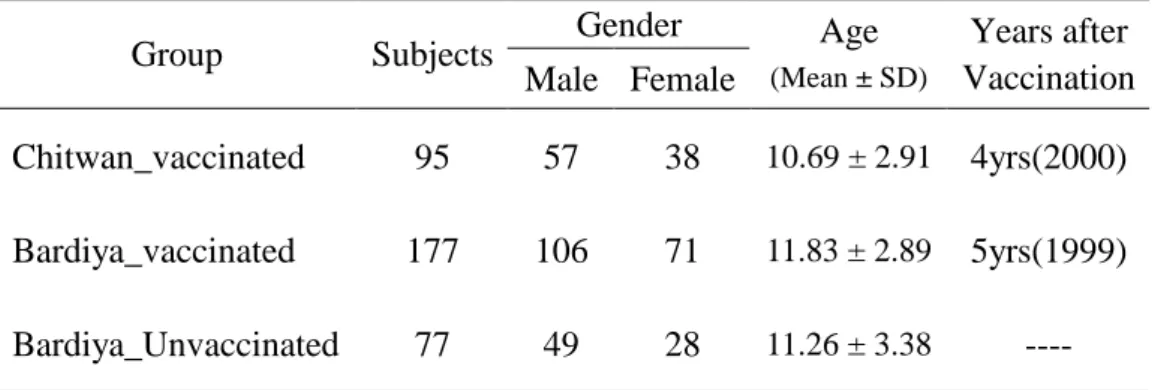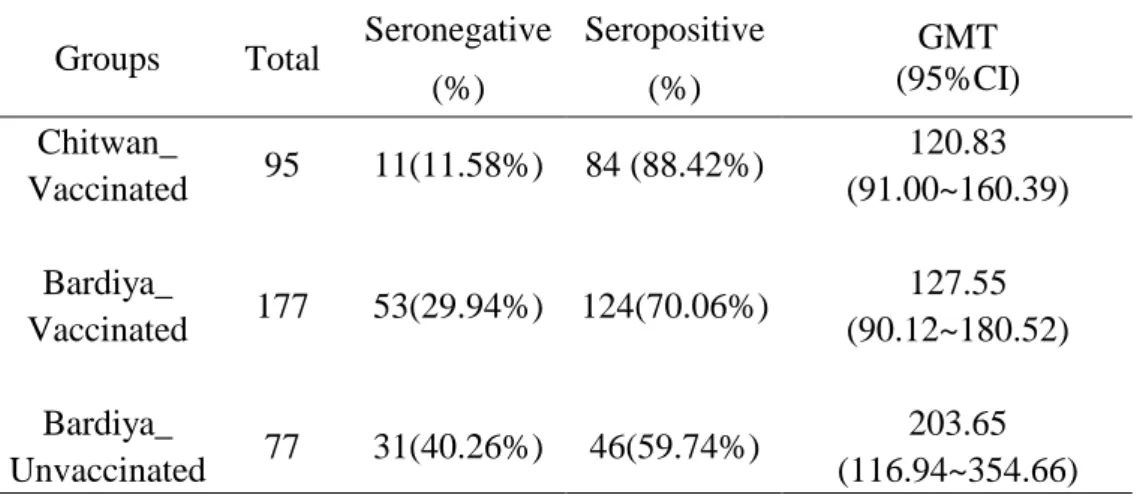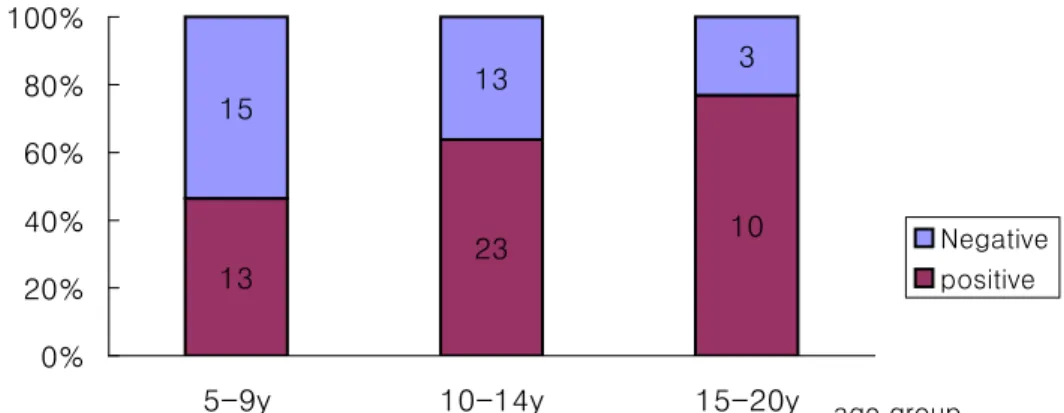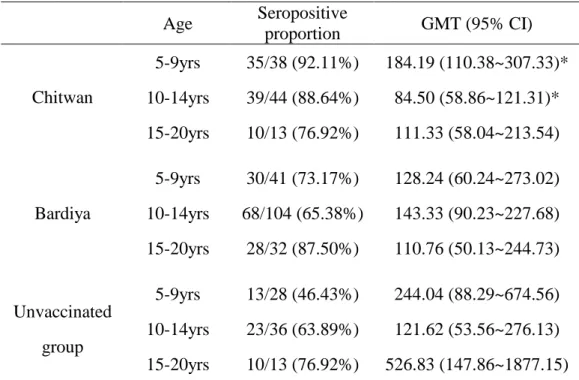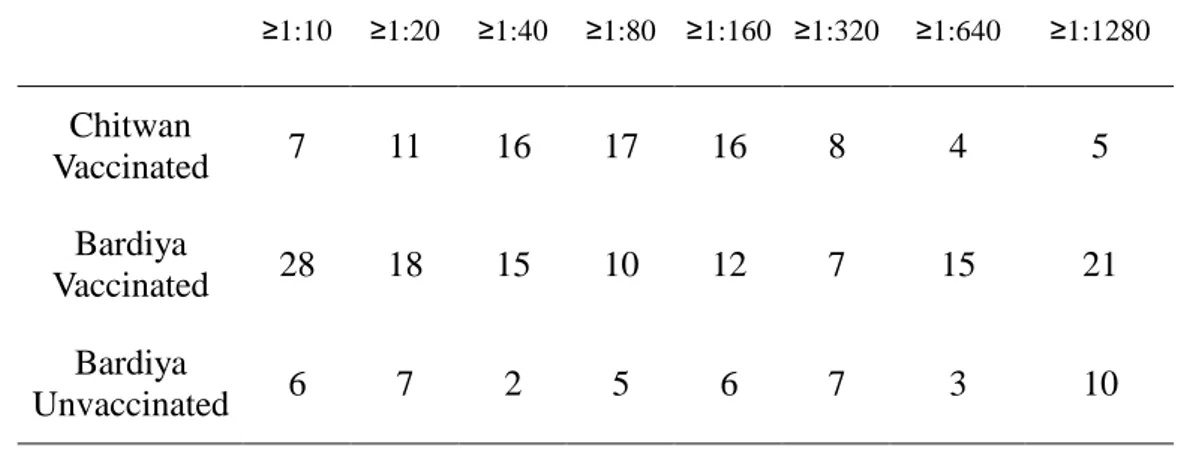Live-attenuated Japanese Encephalitis Vaccine:
Persistence of Antibody up to 5 Years after
A Single Dose Regimen
Min JI
Graduate School of Public Health
Yonsei University
Live-attenuated Japanese Encephalitis Vaccine:
Persistence of Antibody up to 5 Years after
A Single Dose Regimen
A Master’s Thesis Submitted to the
Graduate School of Public Health
Yonsei University in partial fulfillment of the
requirement for the degree of
Master of Public Health
Min JI
December 2004
This certifies that the master’s thesis of Min JI is approved.
Thesis Supervisor: Heechoul Ohrr
Chong Mo Nam
ACKNOWLEDGEMENTS
At the onset, I would take the opportunity to thank my advisor, Professor Heechoul Ohrr, for providing guidance, valuable suggestions during my days at Yonsei University as a graduate student starting from very beginning. Without his inspiration, encouragement and support this thesis wouldn’t have seen the light. I am also benefited from the advice and guidance of many other faculty members at Yonsei University. In particular I would like to thank Professor Chung Mo Nam and Professor Sun Ha Jee who were especially generous with their time, support and encouragement, spent their time reading the draft and providing valuable feedback. Last but not the least, I am grateful to my closest people, my parents and my husband Minseok Shin, mostly for their continuous love, support and sacrifices. This thesis is dedicated to them.
Table of Contents
ABSTRACT ...IV I. INTRODUCTION ... 1 II. METHODS... 4 2.1 STUDY SITE... 4 2.2 STUDY POPULATION... 4 2.3 SEROLOGIC TEST... 5 2.4 STATISTICAL ANALYSIS... 6 III. RESULTS ... 7 3.1 DEMOGRAPHICS... 7 3.2 SEROLOGICAL ASSAY... 8 3.2.1 Seropositive proportion... 83.2.2 Geometric Mean Titer... 11
3.2.3 Distribution of Neutralizing antibody titer... 11
IV. DISCUSSION ... 14
REFERENCE... 18
List of Figures
Fig 1. JE prevalence areas in Nepal………4 Fig 2. Seropositive proportion among different age groups…………9
Fig 2-1 Chitwan_Vaccinated group Fig 2-2 Bardiya_Vaccinated group Fig 2-3 Bardiya_Unvaccinated group
Fig 3. Seropositive proportion between genders………11 Fig 4. Titer distribution among different group………12
Fig 4-1 Chitwan_Vaccinated group Fig 4-2 Bardiya_Vaccinated group Fig 4-3 Bardiya_Unvaccinated group
List of Tables
Table 1. Characteristics of subjects within study groups……….7 Table 2. Seroprevelance of JE neutralizing antibody in study groups……8 Table 3. Seropositive proportion among different age groups………10 Table 4. Distribution of JE neutralizing (PRNT) antibody………12
ABSTRACT
Purpose: To evaluate serologic response pattern to single dose vaccination of Live JE vaccine over long term period in JE endemic area.
Method: Single dose of live JE vaccine were given in Bardiya (July, 1999), and Chitwan (June, 2000). Serum collected for antibody determination was drawn from 349 subjects at June 2004. JE neutralizing antibody was determined by plaque reduction neutralization test (PRNT).
Result: 71.2~88.4% of subjects persist protective antibody (titer ≥1:10)
over 4~5 years after Single dose of live JE vaccine, with geometric mean titer (GMT) as 120.83 and 121.81, respectively.
Conclusion: Neutralizing antibody response from single dose of live JE
vaccine persist at least 5 years in healthy Nepali children. Single dose of live attenuated SA14-14-2 JE vaccine is a good alternative to protection against JE for high risk population and travelers visiting Western-Pacific Asian.
I. INTRODUCTION
Japanese encephalitis is the leading viral cause of encephalitis and disability in Asia. The disease primarily infects children under the age of 15, leaving up to 70 percent of those who develop illness either dead or with a long-term neurological disability. Since the first case of JE was documented in the late 19th century, JE has spread to as far south as Australia and as far west as Pakistan. Over the past 60 years JE has infected an estimated 10 million children, killing 3 million and causing long-term disability in 4 million more. JE control has been hindered by poor surveillance limited and unstable vaccine supply; lack of guidance an programmatic support for JE immunization, and low political awareness of the disease.[1-3]
The only internationally distributed JE vaccine is an inactivated vaccine purified from infected mouse brains, which was developed in 1941 and is used to control the disease in richer countries and to protect travelers, but it has not reached many of the poorest countries in Asia.[4-7] Although the inactivated vaccine is efficacious, its high cost – at US$9 - US$15 for the three doses
needed to fully immunize a child, limited in production, and requiring periodic booster doses, make it difficult to integrate the vaccine into routine immunization programmes. Recently the vaccine has also been associated with underdesirable hypersensitivity-type reactions.[8-11] A more readily available and safer vaccine is needed.[12]
The most promising candidate vaccine is a live, attenuated JE vaccine (SA14-14-2), which was licensed in China since 1988, it has been administered to over 200 million Chinese children, with good disease control and no reports of serious complications.[13-18] In China, this vaccine is recommended as three doses at age 1, 2 and 6 years. This schedule was not adopted as a result of efficacy data but rather following custom of administering JE vaccines in annual spring campaigns and the schedule of inactivated JE vaccine, which requires booster doses every 2 to 3 years. An updated vaccine schedule based on scientific proofs is needed so that the live JE vaccine can be integrated into routine childhood immunization schedules in most Asian countries.
aged 1-15 years, living in the Terai region, the JE endemic areas. A case-control study showed that the efficacy of a single dose of JE vaccine is observed above 99% within one week of administration.[19] This study tried to evaluate the serologic response pattern in those vaccinated population over long term period in JE endemic area.
II. METHODS
2.1 S
TUDYS
ITESubjects were recruited from two districts -- Bardiya and Chitwan, are of the Terai region of Nepal.
The region is flat land with less than 300 meters part of Nepal, where is an agriculture area for rice,
and belongs to the subtropical area with a monsoon climate. According to baseline survey on 1~15 years old children, JE seropositive prevalence was 22.8% in Bardiya in year 1999, 1% in Chitwan in year 2000.
2.2 S
TUDY POPULATION254 subjects aged 6 to 20 years old were recruited from Bardiya district, 177 were received single dose of Live JE vaccine in July 1999 (Bardiya Vaccinated Group); and 77 subjects had not received any JE vaccine were included as control group (Bardiya Unvaccinated Group). 95 subjects recruited from
Chitwan were children aged between 5 to 19 years old, who received single dose of JE vaccine in June 2000 (Chitwan Vaccinated Group).
All enrolled subjects were verified their vaccination status by interview and vaccine registry logbook. Medical history of JE infection or related clinical symptom were questioned and recorded.
2.3 S
EROLOGICT
ESTA total of 349 serum samples were collected from two districts on June 2004. 5ml of whole blood were withdrawn from each subject, sera were centrifuged within 2 hours after collection. Separated sera were kept under –20ºC before testing.
Serum specimens were sent to the JE lab at Mahedole University, Thailand. Specimens were labeled to mask the date that each specimen was drawn, and participants’ location.
Neutralizing antibody was determined by PRNT.[22] Test was performed according to Mahedole University customary protocol. Serum samples were inactivated at 56ºC for 0.5h. Serial dilutions (2 fold) were made from an
initial 1:5 dilution. About 100 pfu of JE virus (Beijing strain) was incubated with each serum dilution overnight at 4ºC. The virus-serum mixtures (final serum dilution of 1:5) were inoculated onto drained LLC-MK2 cell monolayers grown in 6-well panels. After viral adsorption(0.5h at 37ºC), monolayers were overlaid with a solid nutrient medium. One week later, Panels are fixed and stained with crystal violet, plaques were counted. The neutralization endpoint in the protocol was a 50% reduction in plaque formation, and antibody titer ≥1:10 was considered positive and protective.[4]
2.4 S
TATISTICAL ANALYSISAll data were entered into a computerized database, verified for accuracy, and analyzed using SPSS Version 10. Seropositive was defined as titer ≥1:10. Geometric mean titers (GMTs) were determined by log-transformation of individual titers and use of the anti-log of the mean of transformed values for seropositive subjects. The 2 or Fisher's exact test was used to compare the proportions of seropositive, while the GMTs were compared using the Mann-Whitney U test. A p value of <0.05 was considered statistically significant.
III.
Results
3.1 D
EMOGRAPHICSTable 1 shows demographic information of three study groups. Bardiya vaccination group consisted of 177 subjects, 71(40%) female and 106 (60%) male, with an average age of 11.83 ± 2.89 years. Unvaccinated group in Bardiya consisted of 77 subjects, 28(36%) female and 49 (64%) male, with an average age of 11.26±3.38. Among 143 subjects in Chitwan group, 38(40%) female and 57 (60%) male, with an average age of 10.69±2.91 years. Chitwan group consists more proportion of younger age subjects.
Table 1. Characteristics of subjects within study groups Gender Group Subjects Male Female Age (Mean ± SD) Years after Vaccination Chitwan_vaccinated 95 57 38 10.69 ± 2.91 4yrs(2000) Bardiya_vaccinated 177 106 71 11.83 ± 2.89 5yrs(1999) Bardiya_Unvaccinated 77 49 28 11.26 ± 3.38 ---- SD: Standard Deviation
3.2 S
EROLOGICALA
SSAY 3.2.1 Seropositive proportionSeropositive proportions are 88.4% and 70.1% in Chitwan and Bardiya vaccinated groups, respectively. 59.7% unvaccinated subjects showed seropositive in Bardiya_unvaccinated group(Table 2).
Table 2. Seroprevelance of JE neutralizing antibody in study groups
Groups Total Seronegative (%) Seropositive (%) GMT (95%CI) 120.83 Chitwan_ Vaccinated 95 11(11.58%) 84 (88.42%) (91.00~160.39) 127.55 Bardiya_ Vaccinated 177 53(29.94%) 124(70.06%) (90.12~180.52) 203.65 Bardiya_ Unvaccinated 77 31(40.26%) 46(59.74%) (116.94~354.66)
95%C.I.: 95%Confidence Interval
Seroprevalence in age groups
No significant difference of seropositive proportion is observed among different age groups (Figure 2(1~3) and Table 3). In Bardiya_unvaccinated group, seropositive proportion show trendily increase with age, the higher the elder children group (P =0.053)
Fig. 2-1 Seroprevalence in Chitwan_Vaccinated Group 35 39 10 3 5 3 0% 20% 40% 60% 80% 100%
5-9y 10-14y 15-20y age group Negative positive
Fig. 2-2 Seroprevalence in Bardiya_Vaccinated Group
30 68 28 11 36 4 0% 20% 40% 60% 80% 100%
5-9y 10-14y 15-20y age group
Negative positive
Fig 2-3. Seroprevalence in Bardiya_Unvaccinated group
13 23 10 15 13 3 0% 20% 40% 60% 80% 100%
5-9y 10-14y 15-20y age group
Negative positive
Table 3. Seropositive proportion among different age groups Age Seropositive proportion GMT (95% CI) 5-9yrs 35/38 (92.11%) 184.19 (110.38~307.33)* 10-14yrs 39/44 (88.64%) 84.50 (58.86~121.31)* Chitwan 15-20yrs 10/13 (76.92%) 111.33 (58.04~213.54) 5-9yrs 30/41 (73.17%) 128.24 (60.24~273.02) 10-14yrs 68/104 (65.38%) 143.33 (90.23~227.68) Bardiya 15-20yrs 28/32 (87.50%) 110.76 (50.13~244.73) 5-9yrs 13/28 (46.43%) 244.04 (88.29~674.56) 10-14yrs 23/36 (63.89%) 121.62 (53.56~276.13) Unvaccinated group 15-20yrs 10/13 (76.92%) 526.83 (147.86~1877.15)
The mean difference between age group 5-9ys and 10-14ys is significant.
Seroprevalence in Gender
In unvaccinated group, higher seroprportions are found in males (65.3% vs. 50%). No significant difference of seropositive proportion is observed in different genders in either group (Fig 3).
Fig3. Seroprevalence in different genders 32 51 75 35 49 17 20 31 3 8 14 14 0% 20% 40% 60% 80% 100%
Female Male Female Male Female Male
Bardiya_unvaccinated Bardiya_vaccinated Chitwan_vaccinated
Negative Positive
3.2.2 GMT
GMT titers are 120.83, 131.81 and 203.65 in Chitwan, Bardiya and Bardiya unvaccinated group, respectively. No significant difference of GMT titer is observed among these study groups (Table 2).
3.2.3 Distribution of Neutralizing antibody titer
Table 4 and Figure 4 (1-3) shows the distribution of JE neutralizing (PRNT) antibody. Normal distribution is shown in Chitwan group, most of positive sera (58%) have titers between 1:40~1:160. PRNT titer shows exponential
have titers between 1:10~1:40, and a certain proportion (12%) have titers above 1:1280.
Table 4. Distribution of JE neutralizing (PRNT) antibody
≥1:10 ≥1:20 ≥1:40 ≥1:80 ≥1:160 ≥1:320 ≥1:640 ≥1:1280 Chitwan Vaccinated 7 11 16 17 16 8 4 5 Bardiya Vaccinated 28 18 15 10 12 7 15 21 Bardiya Unvaccinated 6 7 2 5 6 7 3 10
Fig. 4-1 PRNT titer distribution - Chitwan_vaccinated group 0 5 10 15 20 ≥10 ≥20 ≥1:40 ≥1:80 ≥1:160 ≥1:320 ≥1:640 ≥1:1280 Titer N u m b e r o f s u b je c ts
Fig.4-2 PRNT titer distribution - Bardiya_Vaccinated Group 0 5 10 15 20 25 30 ≥10 ≥20 ≥1:40 ≥1:80 ≥1:160 ≥1:320 ≥1:640 ≥1:1280 Titer N u m b e r o f s u b je c ts
Fig.4-3 PRNT titer distribution - Bardiya_Unvaccinated Group 0 2 4 6 8 10 12 ≥10 ≥20 ≥1:40 ≥1:80 ≥1:160 ≥1:320 ≥1:640 ≥1:1280 Titer N u m b e r o f s u b je c ts
IV. DISCUSSION
Efficacy of single dose of live JE vaccine (SA14-14-2) was studied in Nepal in 1999, as the first study outside China, showed the efficacy over 99%.[19] This JE seroprevelance study among the above-mentioned population showed 71.2~88.4% seropositive after 4~5 years vaccination, indicating that single dose regimen can provide an immunity at least the 4~5 years. Similar study done in non JE endemic area in China showed that 57.1% of subjects with persistence of antibody over 6 years after vaccination of two doses.[23]
In Nepal, nearly 70% of all JE cases were reported from the three districts: Bardiya, Kalali and Banke.[20] In our study, 59.7% unvaccinated subjects were seropositive, indicating high apparent infections existed in study area. While data from baseline survey in Chitwan district, showed 1% of children 1 to 15 years old were seropositve, which was consistent with other serological study in Chitwan[21] which showed that no children aged below 10 years were seropositive to JE. Therefore, we may regard Bardiya as JE high endemic area, while Chitwan as low endemic area. In evaluating the serologic
response to vaccine administered in endemic area, consideration must be given to the influence that subclinical or inapparent infections may have on the serologic status of the vaccinees. Sera were collected in June, just before the start of JE peak season. In Bardiya_vaccinated group, 77.1% subjects were seropositive, higher than unvaccinated group (59.7%). The PRNT titer distribution similar to exponential distribution, may present the antibodies waned by time, while certain portion of positive (12%) had high titers above 1:1280, which may reflect natural booster effect.
In spite of the natural booster effects, the difference of seropositive proportion between two vaccinated groups in Chitwan and Baridya (88.4% vs. 71.2%) may due to the different vaccine potency. Vaccine lot with 106.3 plague forming unit per dose were given in Chitwan group, which was about 2 times higher dose than those given to Bardiya group. Our data support the recommendation that using a lyophilized SA 14-14-2 vaccine with a titer of at least 106.0 PFU per dose administered as a single dose is highly immunogenicity at modest cost and can meet the global requirements for JE vaccine.
In JE virus infection, antibody has been considered to play an important role in protection, while a role of cellular immunity in protection has also been reported. As observed in animal trial, the adoptive transfer of JE virus-immune T cells protected mice from lethal challenge. [24-26] Mice infected with JE virus developed cytotoxic T lymphocytes (CTLs) that were able to lyse JE virus-infected cells.[26,27] These reports suggested that in addition to antibodies, CTLs are important in protection from JE. The induction of CTLs as well as antibody is considered to be an advantage of live-attenuated vaccines over the inactivated JE vaccine. Though about 30% vaccinated subjects in Bardiya did not have detectable protective antibody after 5 years of vaccination, which may not mean subjects loose protection from JE. No JE cases reported or signs of clinical illness recorded among the study subjects during the 4 to 5 years after vaccination.
To successfully control JE in all affected countries, a vaccine must be affordable, safe and effective, and fit easily into routine immunization. Our study indicates that the neutralizing antibody response from single dose of live JE vaccine persist at least 5 years in healthy Nepali children, and single dose
vaccination of live JE vaccine evidently provide sufficient immunological memory, supplemented possibly by natural exposures to the virus, to be highly effective in protecting against clinical illness. Single dose of live JE vaccine can be well integrated into the routine immunization schedule in most of Asian countries.
REFERENCE
1. Tsai TF, Chang G.J and Yu YX. Japanese encephalitis vaccines. In: Plotkin SA and Orenstein WA, editors. Vaccines. 3rd ed. Philadephia, WB Saunders, 1999: 672-710.
2. Solomon T, Dung NM, Kneen R, et al. "Japanese encephalitis." J Neurol Neurosurg Psychiatry 2000; 68(4):405-15
3 Web page: "Japanese Encephalitis Project. By Children’s Vaccine Program" http://www.childrensvaccine.org/html/jep.htm. Accessed December 2004.
4. Centers for Disease Control and Prevention. "Inactivated Japanese encephalitis virus vaccine. Recommendations of the Advisory Committee on Immunization Practices (ACIP)." MMWR 1993; 42(RR-1):1-14
5. WHO. Japanese encephalitis vaccines. WHO position paper. Wkly Epidemiol Rec 1998; 73: 337-44
6. Defraites RF, Gambel JM, Hoke CH, et al. Japanese encephalitis vaccine (inactivated, BIKEN) in U.S. soldiers: immunogenicity and safety of
vaccine administered in two dosing regimens. Am J Trop Med Hyg 1999 61(2):288-93
7. Hoke CH, Nisalak A, Sangkawibha N, et al. Protection against Japanese encephalitis by inactivated vaccines. N Engl J Med 1988; 319: 608–14
8. Takahashi H, Pool V, Tsai TF, et al. Adverse events after Japanese encephalitis vaccination: review of post-marketing surveillance data from Japan and the United States. Vaccine 2000; 18: 2963–69
9. Plesner AM, Ronne T. Allergic mucocutaneous reactions to Japanese encephalitis vaccine. Vaccine 1997;15: 1239-43
10. Ruff TA, Eisen D, Fuller A et al. Adverse reactions to Japanese encephalitis vaccine. Lancet 1991;338(8771):881-2
11. Anderson MM, Ronne T. Side Effects with Japanese Encephalitis Vaccine. Lancet 1991;337(8748): 1044
12. Tsai TF. New initiatives for the control of Japanese encephalitis by vaccination. Vaccine 2000; 18: 1–25
highly attenuated live vaccine strain of Japanese encephalitis II: safety and immunogenicity of live JBE vaccine SA 14-14-2 observed in inoculated children. Chin J Microbiol Immunol 1983; 3: 245–8
14. YX Yu, ZG. Ming, Safety of a live-attenuated Japanese encephalitis virus vaccine (SA 14-14-2) for children. Am J Trop Med Hyg 1988; 39: 214–7
15. Hennessy S, Liu ZL, Tsai TF, et al. Effectiveness of live-attenuated Japanese encephalitis vaccine (SA 14-14-2): a case-control study. Lancet 1996; 347(9015): 1583–6
16. Liu ZL, Hennessy S, Strom BL, et al. Short-term safety of live-attenuated Japanese encephalitis vaccine (SA14-14-2): results of a randomized trial with 26,239 subjects. J Infect Dis 1997; 176 :1366–9
17. Tsai TF, Yu YX, Jia LL, et al., Immunogenicity of live attenuated SA 14-14-2 Japanese encephalitis vaccine – a comparison of 1- and 3-month immunization schedules. J Infect Dis 1998; 177 : 221–3
18. Sohn YM, Park MS, Rho HO, et al. Primary and booster immune responses to SA 14-14-2 Japanese encephalitis vaccine in Korean infants.
Vaccine 1999; 17: 2259–64
19. Bista MB, Banerjee MK, Shin SH et al. Efficacy of single-dose SA 14-14-2 vaccine against Japanese encephalitis: a case control study. Lancet 2001;358(9284):791-5
20 OJHA GP, Shrestha KD, Shrestha JM, et al. Epidemiological situation of Japanese Encephalitis in Nepal 2001. In: Annual report of Epidemiology and Disease control division, Nepal.
21 Ogawa S, Shrestha M, Rai S. Serological and virological studies of Japanese encephalitis in the terai region of Nepal. Southeast Asean J Trop Med Public Health 1992; 23(1):37-43
22 Russell PK, Nisalak A, Sukhavachana P, et al. A plaque reduction test for dengue virus neutralizing antibodies. J Immunol 1967; 99:285-90. 23. Jia LL, Yu YX, Shin Sunheang. Observation on persistence of
neutralizing antibody after inoculation of Japanese Encephalitis live attenuated vaccine in volunteers. Chin J Vaccines Immun 2003;9(2):111-4
24 Matumoto M, Kitaoka M. Evaluation of Japanese B Encephalitis Vaccine: II. Serologic Response Following Subcutaneous and Intradermal Administration. Am J Hyg 1956; 63(3):228-9
25. Miura K,Onodera T, Nishida A, et al. A single gene controls resistance to Japanese encephalitis virus in mice. Arch Virol 1990;112: 261–70
26. Tigertt WD, Berge TO. Evaluation of Japanese B encephalitis vaccine: IV. Pattern of serologic response to vaccination over a five-year period in an endemic area (Okayama, Japan). Am J Hyg 1956; 62(3):238-49
27. Murali-Krishna K, Ravi V. and Manjunath R. Protection of adult but not newborn mice against lethal intracerebral challenge with Japanese encephalitis virus by adoptively transferred virus-specific cytotoxic T lymphocytes: requirement for L3T4+ T cells. J Gen Virol 1996;77: 705–14
28. Konishi E, Kurane I, Mason PW, et al. Poxvirus-based Japanese encephalitis vaccine candidates induce JE virus-specific CD8+ cytotoxic T lymphocytes in mice. Virology 1997; 227: 353–60
국문요약
국문요약
국문요약
국문요약
일본뇌염
일본뇌염
일본뇌염
일본뇌염
생백신
생백신
생백신
생백신(SA14
(SA14
(SA14-
(SA14
--
-14
14-
14
14
--
-2)
2)
2)
2) 일회접종후
일회접종후
일회접종후
일회접종후
5
55
5년
년
년
년
항체
항체
항체
항체
양성율을
양성율을
양성율을
양성율을
조사
조사
조사
조사
연구
연구
연구
연구
연세대학교 보건대학원 역학 및 보건증진학과 지 민 목 목 목 목 적 적적:::: 일본뇌염 생백신의 장기면역효과를 예측하기 위한 1999년과 적 2000년에 네팔에서 일본뇌염 생백신을 1회 접종한 아이들의 중화 항체 보유율을 조사한다. 방 방 방 방 법법법:::: 2004년 6월 일본뇌염 생백신을 접종한 5~20세군 272명과 일본뇌법 염 백신을 접종하지않은 77명을 대상으로 혈액학적검사 및 중화 항체가 검사를 위한 채혈을 실시하였다. 플라그 감소 중화항체 검 사법의 양성 기준은 50% 플라그 감소를 기준으로 시험 혈청 희 석 배수가 1:10 미만인 자를 음성으로, 1:10 이상인 자를 양성으 로 판정하였다. 접종 후 4~5년간 중화항체 보유율을 조사하였다.
결 결결 결 과과과과:::: 일본뇌염 생백신을 1회 접종한 사람들의 일본뇌염 항체양성율 은 71.2% ~ 88.4%, GMT는 120.83 과 121.81 이었고, 일본뇌염 백신을 접종하지않은 사람들의 항체양성율은 59.7%, GMT는 203.65 이었다. 결 결결 결 론론론론:::: 일본뇌염 환자가 발생하는 지역에서 연령(1~15세) 대상으로 일본 뇌염 생백신을 1회만 접종해도 접종 후 최소4~5년간은 이들이 중화항체를 유지하고 있다. 일본뇌염, 생백신, 항체양성율
